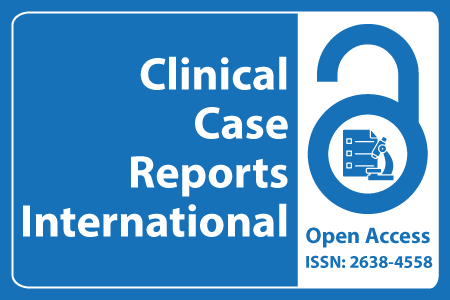
Journal Basic Info
- Impact Factor: 0.285**
- H-Index: 6
- ISSN: 2638-4558
- DOI: 10.25107/2638-4558
Major Scope
- Dermatology and Cosmetology
- Autism
- Inflammation
- Dentistry and Oral Medicine
- Hepatology
- Respiratory Medicine
- Trauma
- Neurology
Abstract
Citation: Clin Case Rep Int. 2023;7(1):1548.DOI: 10.25107/2638-4558.1548
Modified Hackethal’s Technique with Bone Grafting and Plate Fixation: A Case Report of Treatment for Pathological Humeral Shaft Fracture
Lin CY, Tai TH, Tu TY, Liaw CK and Chiu YS
School of Medicine, College of Medicine, Taipei Medical University, Taiwan
Department of Medical Education, Division of General Medicine, Shuang Ho Hospital, Taipei Medical University, Taiwan
Department of Orthopedics, Shuang Ho Hospital, Taipei Medical University, Taiwan
Department of Orthopedics, Kaohsiung Veterans General Hospital, Taiwan
Graduate Institute of Biomedical Optomechatronics, College of Biomedical Engineering, Research Center of Biomedical Devices, Taipei Medical University, Taiwan
These authors contributed equally to this work
*Correspondance to: Yen-Shuo Chiu
PDF Full Text Case Report | Open Access
Abstract:
Background: Pathological Humeral Shaft Fracture (PHSF) is a common clinical manifestation of multiple myeloma, and surgical intervention is indicated for symptom relief and function restoration. However, the most effective surgical technique for PHSF remains uncertain. Conventional nailing has several disadvantages, including potential loss of fixation, local tumor progression, risk of radial nerve injury, and shoulder complications. We employed a modified version of Hackethal’s technique that involves intramedullary K-wire combined with bone grafting and plate fixation; such a technique has not yet been widely reported. This novel technique offers immediate rigidity, restores function, decreases tumor burden, and causes fewer shoulder complications than other techniques. Case Report: A 74-year-old man who lives in the Marshall Islands presented to our orthopedic outpatient department in Taiwan with left arm pain and a swelling sensation that had persisted for a month. Laboratory evaluations revealed normocytic anemia, hypercalcemia, hypoalbuminemia, and hyperglobulinemia. Plain films of the left arm showed a 10-cm osteolytic lesion on the left humeral shaft and multiple small lesions. Magnetic resonance imaging revealed a soft mass on the humeral shaft. To restore function and determine the origin of the shaft lesion, we used a novel, modified version of Hackethal’s technique. Discussion: We discuss the differences among intramedullary nailing, plating, and prosthesis insertion and describe the advantages of our novel technique. We review the literature and suggest various surgical techniques for PHSF. Take-home message: The combination of allogenic bone grafting, intramedullary K-wire fixation, plate fixation, and bone cement augmentation in the novel technique we describe may serve an alternative treatment for PHSF involving large lesions. Our technique offers broader lesion excision, fewer shoulder complications, and greater rigidity than other techniques offer.
Keywords:
Cement augmentation; Hackethal’s technique; Metastatic lesion; Multiple myeloma; Pathological humeral shaft fracture; Plate fixation
Cite the Article:
Lin CY, Tai TH, Tu TY, Liaw CK, Chiu YS. Modified Hackethal’s Technique with Bone Grafting and Plate Fixation: A Case Report of Treatment for Pathological Humeral Shaft Fracture. Clin Case Rep Int. 2023; 7: 1548.













